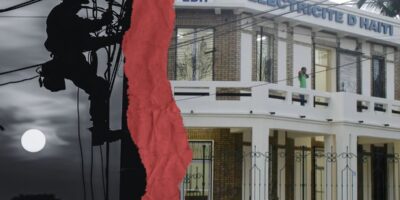Renaud Piarroux is a professor at the faculty of medicine at Sorbonne University. At the request of the Haitian government and the French embassy, he carried out in November 2010 the epidemiological investigation which pointed to the responsibility of the peacekeepers in the importation of the disease. In 2019, he published a work published by the CNRS entitled « Choléra —Haiti 2010-2018 story of a disaster »
This op-ed is available in French, here.
Not a day goes by without my thinking about how the Haitian people have been treated in this grim story of the cholera epidemic. It was late 2010, the year of the earthquake, a violent cholera epidemic had just broken out. In the space of a few weeks, Haiti was devastated by an epidemic shock wave which, through its deadly violence, exceeded all the cholera epidemics of the past twenty years.
We must go back to 1994, the date of the terrible epidemic in the refugee camps around Goma in eastern Zaire, to find comparable violence. And again, in Goma, the outbreak had remained localized to refugee camps and neighboring communities.
In Haiti, the whole territory was hit, from the most inaccessible areas of Port-au-Prince to the hills. An MSF study even found that in some particularly remote rural areas, 1 in 20 people died during the first months of the epidemic. Suffice to say that the official assessment, yet already very severe with more than 800,000 cases and nearly 10,000 deaths, is far from reality.
There was no investigation, in the legal sense of the term, into this health disaster. Neither the Haitian authorities nor the international community saw fit to sponsor such an investigation. No judge adjudicated the case, no police questioned the witnesses.
In their place, experts from all sides were given free rein to present their views in the media. After all these years, rereading their statements still amazes me. I have before me an article from The Guardian, the most serious British newspaper. Entitled, “Haiti’s cholera epidemic caused by weather, say scientists,” dated November 22, 2010. Several scientists are interviewed. They say the epidemic has nothing to do with the arrival of UN soldiers from Nepal, an explanation dubbed « popular belief. »
For these renowned scientists, cholera is the result of a combination of catastrophic events including the earthquake, weather conditions linked to global warming and the aquatic environment from which the epidemic emerged. One of them does not hesitate to opine, saying that the earthquake refugees, installed on the banks of the Artibonite, were the first to catch cholera after drinking water from the river: « Interestingly, the refugees got cholera first. If, as it is likely, cholera was already present in the Haitian coastal region, permanent residents exposed to low levels of the cholera bacterium for prolonged periods of time would logically have more immunity than refugees. » Curious explanation when you know that the nearest refugee camps were located tens of kilometers from the Artibonite river!
These interviews set the tone for a very particular disinformation campaign, since it was largely carried out by experts and organizations which should have informed us about the facts. We can still find stigma on the internet. This is the case, for example, with an interactive map published by the Pan American Health Organization, the American branch of the World Health Organization, where thousands of cholera cases that occurred during the first week of the epidemic in the surroundings of Mirebalais are hidden. However, the organization was aware of it. OCHA, the UN’s office for the coordination of humanitarian affairs, did the same, and other organizations followed suit. With cholera starting near the coast, it was possible to explain that the bacteria responsible had emerged from coastal waters after a phase of local growth. If, on the contrary, the origin of the epidemic was located on the edge of a river passing under the septic tanks of a camp of soldiers just arrived from a country in the grip of an epidemic, that would have been more complicated.
Everyone now knows that, over time, the Nepalese hypothesis finally prevails over the accumulation of epidemiological and genetic evidence. The first cases came from the hamlet located in the immediate vicinity of the peacekeepers camp and the strain was identical in all respects to one of those which had prevailed in Nepal weeks ago. You would think that disinformation would not resist. It just changed.
Thus, Bill Clinton, in an interview given in 2012, admits that a peacekeeper did import cholera, but he immediately adds: « I don’t know that the person who introduced cholera in Haiti, the U.N. peacekeeper, or [U.N.] soldier from South Asia, was aware that he was carrying the virus. » Its purpose is clear, it is to minimize the fault. What can we blame a person who does not even know he is carrying the « virus »? This is how a new fable takes shape: cholera arrived without the knowledge of the UN, through an asymptomatic carrier who did not know he was contagious. This fable hampered the fight against cholera for years and led to the absurd situation we are living in: there is no cholera in Haiti, but no one recognizes it publicly. Besides, practically nobody even dares to believe it!
The assumption that cholera took root in Haiti without everyone’s knowledge does not hold water. Suppose, as Bill Clinton does, that the cholera was really imported by a soldier who did not know he was contagious and that, as the UN has always said, none of his comrades developed diarrhea. So only a limited number of cholera bacteria could have entered the environment, taking advantage of the negligence in the management of the Blue Helmets’ septic tanks.
However, at once, thousands of people fell ill simultaneously while drinking Artibonite water, all along the Mirebalais river at the coast. An attempt at an explanation was then formulated by a panel of experts mandated by the UN: “The canal system and delta of the Artibonite River provided optimal environmental conditions for rapid proliferation of Vibrio cholerae.” But in this case, how to explain the disappearance of cholera from February 2019? The environment is still there, the river, the canals, nothing has changed. The fight that was waged only targeted the human cases and their immediate entourage. The bacteria that was supposed to multiply so easily in river water had no reason to disappear, and therefore, cholera could not be eliminated.
Moreover, this is exactly what the strategic summary of the Cholera Elimination Plan 2013-2022 states: « the bacterium being in the environment, sporadic cases will always be diagnosed. » As a preamble to an elimination plan, it must be recognized that this sentence is not really likely to mobilize the crowds! Neither the donors. For many years, the fight stuck, for lack of sufficient teams to carry it out. It was only at the end of 2016, with humanitarian aid once again surging in the aftermath of Hurricane Matthew, that the number of response teams could be increased significantly and that the fight could be waged effectively.
If it had taken root in the environment, cholera could not have disappeared from Haiti. And yet, let’s open our eyes: for almost a year, all attempts to isolate the bacteria from diarrheal patients – and there have been more than 1,200 so far – have resulted in negative results. No sporadic cases have been diagnosed. This microbe that was so easy to isolate from patients a few years ago has now not been found! In any other country, the end of the epidemic would have been announced. After all, to suggest that Haiti is endemic for cholera is really bad publicity.
But then, if it was not in Artibonite that the bacteria proliferated in October 2010, how overnight could thousands of people get sick by drinking its water?
The only explanation is that the proliferation phase took place upstream. Among the soldiers. And this is such an embarrassing truth that no one dares to take it for granted. Because it implies that the disaster could have been avoided if, when the first cases occurred among soldiers, measures had been taken to neutralize the contents of the filling septic tanks. A few days later, the septic tanks were emptied, their contents discharged into a tributary flowing into the Artibonite river, and the water of the Artibonite river became massively poisoned.
What a horrible story !
Renaud Piarroux, M.D., Ph.D.







Comments